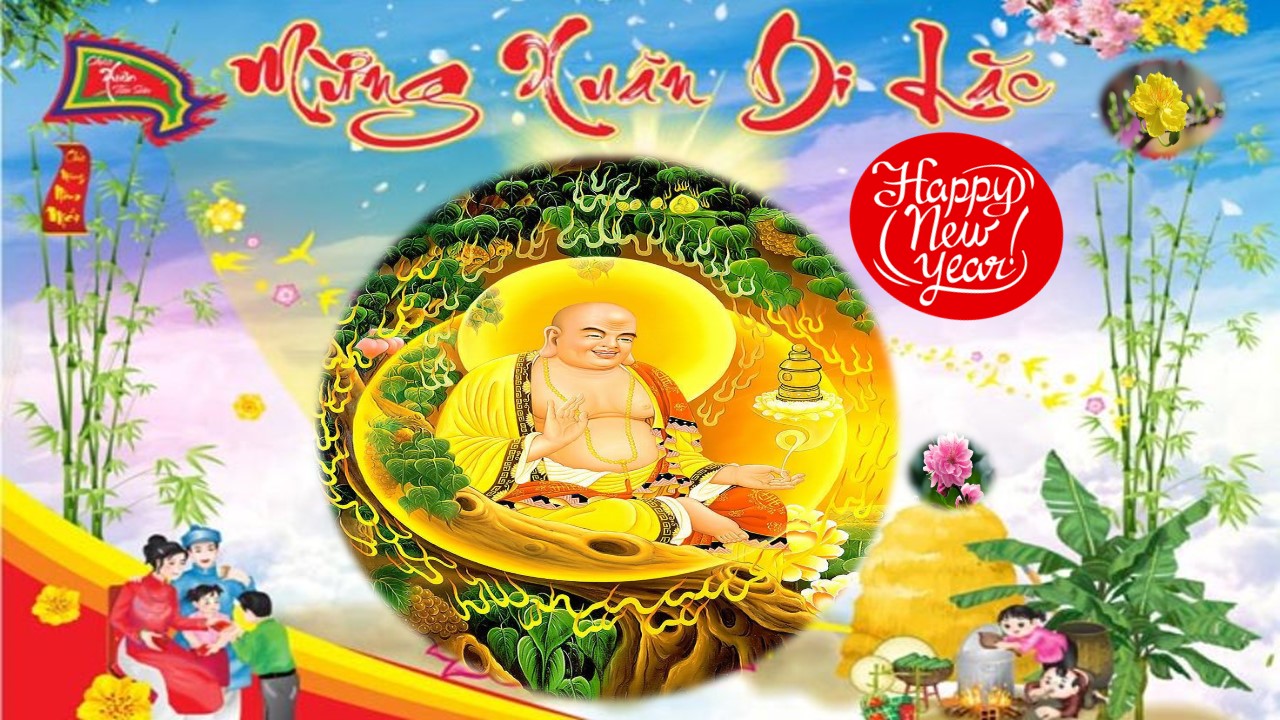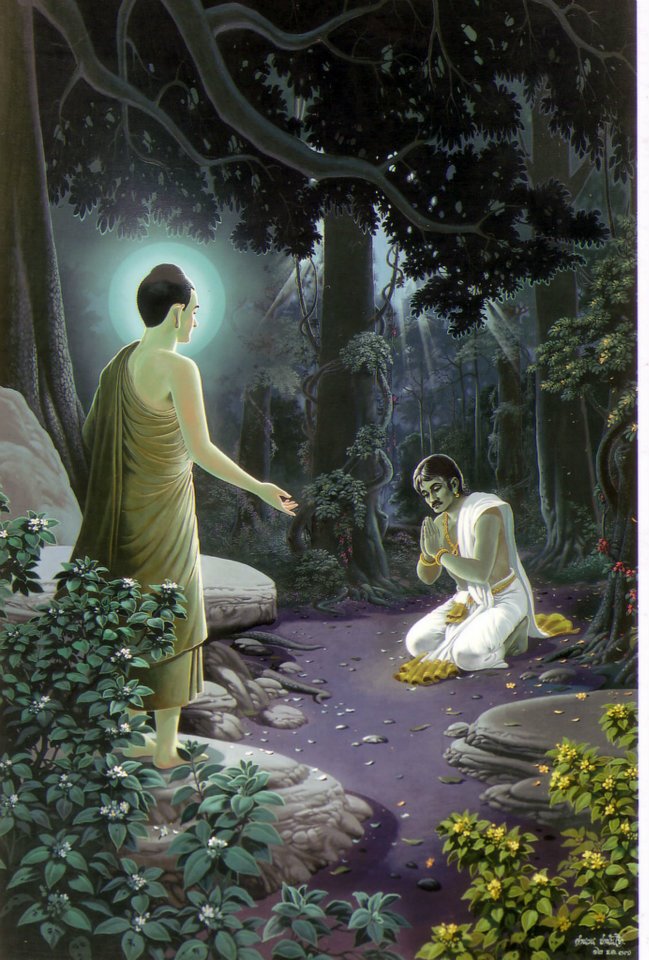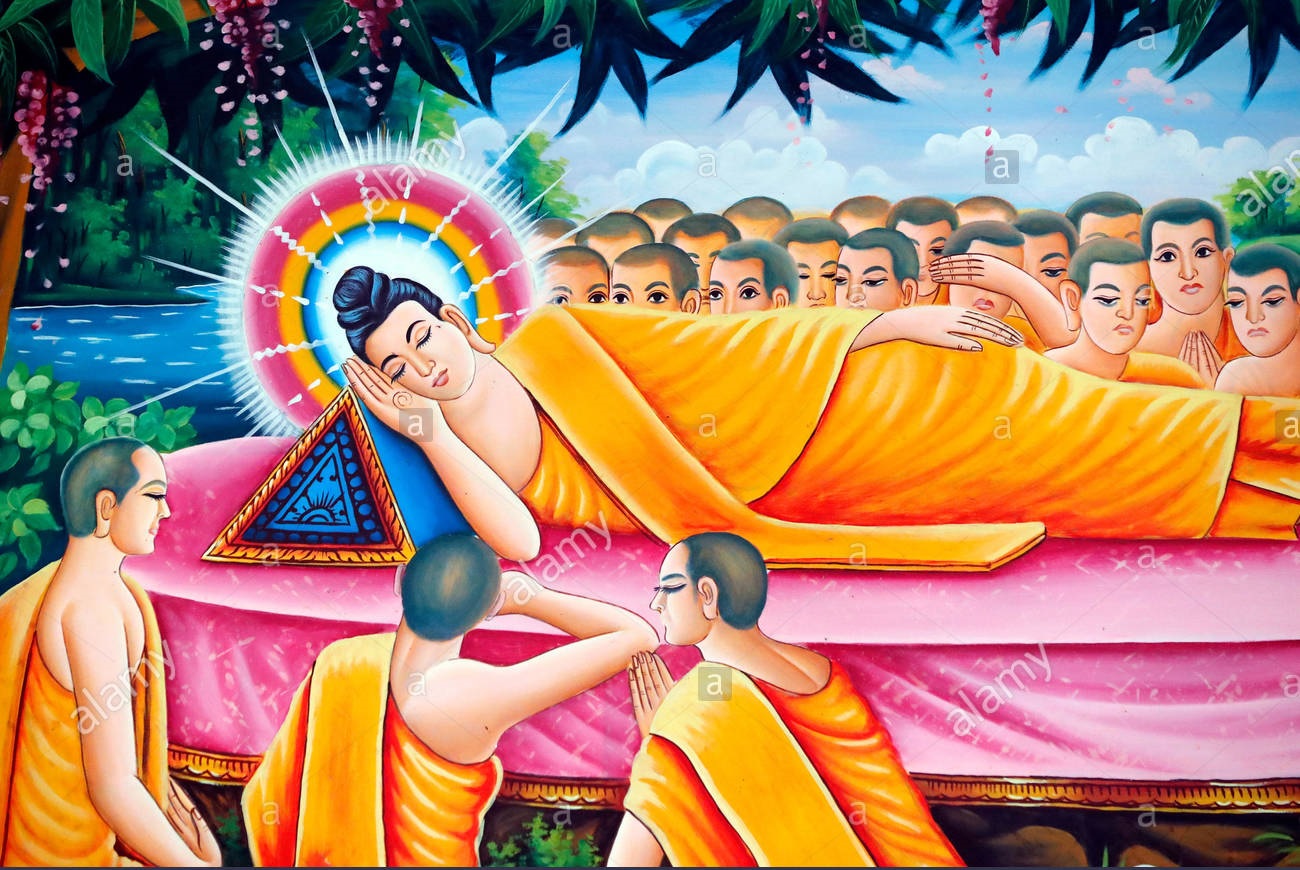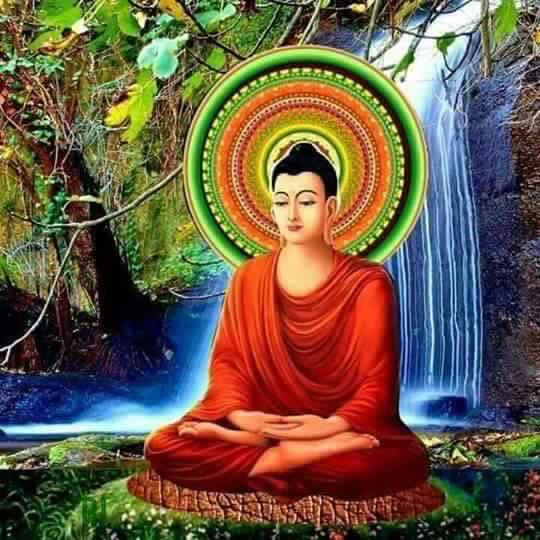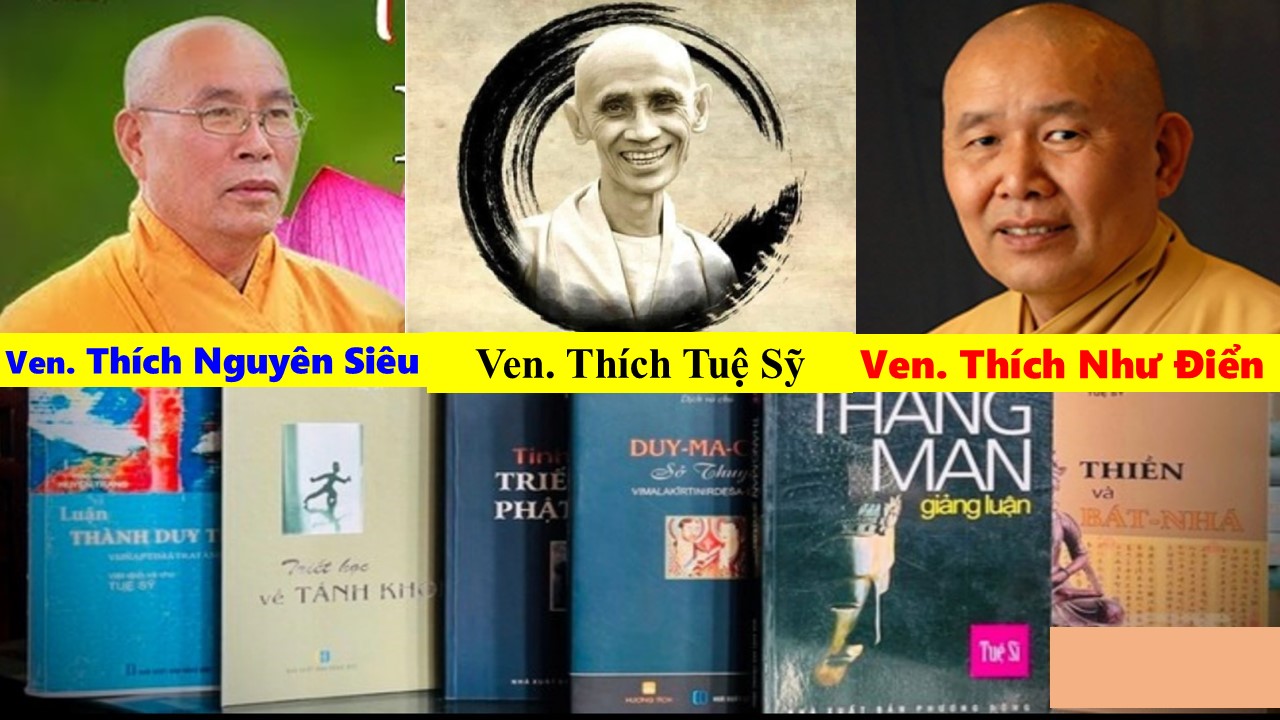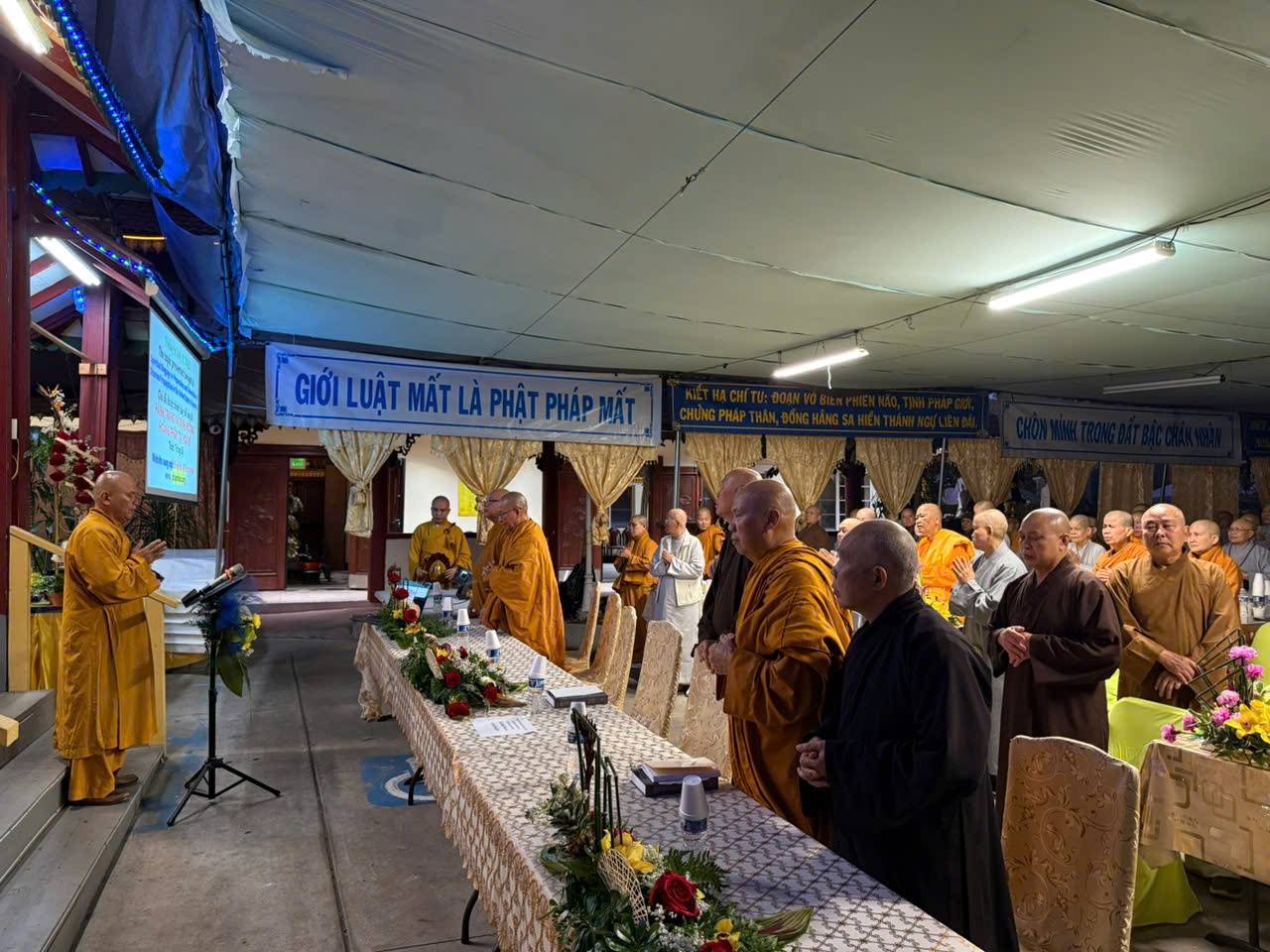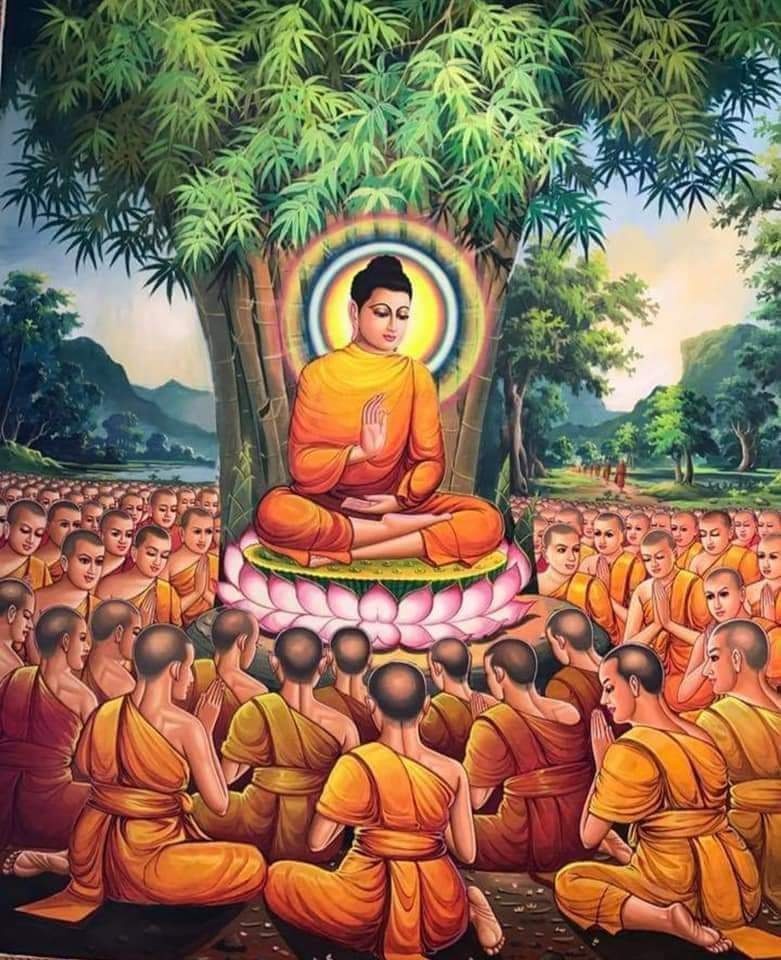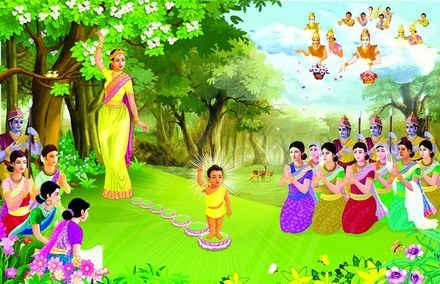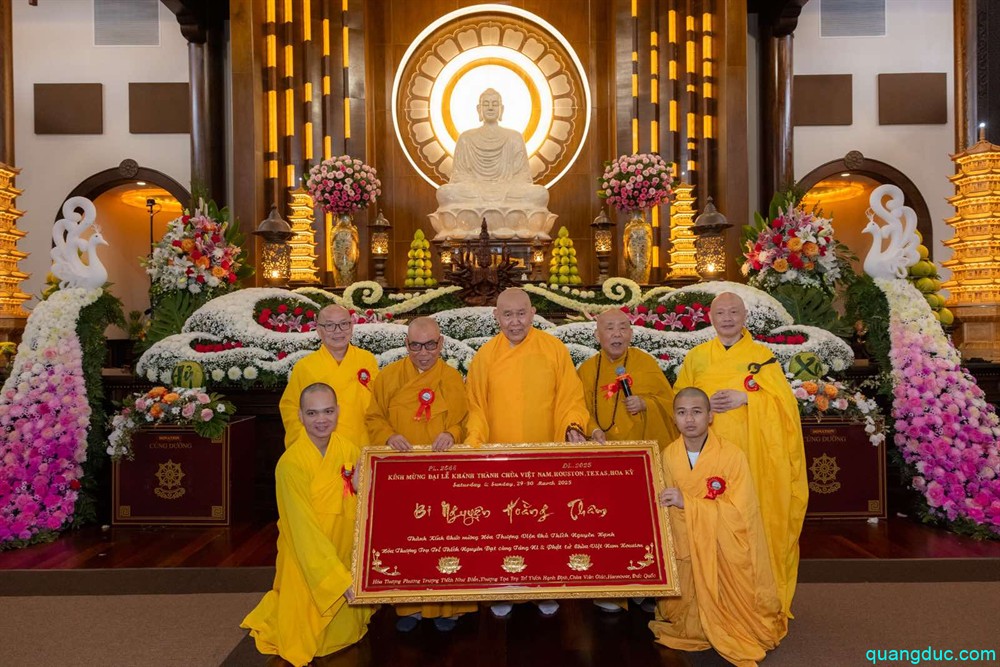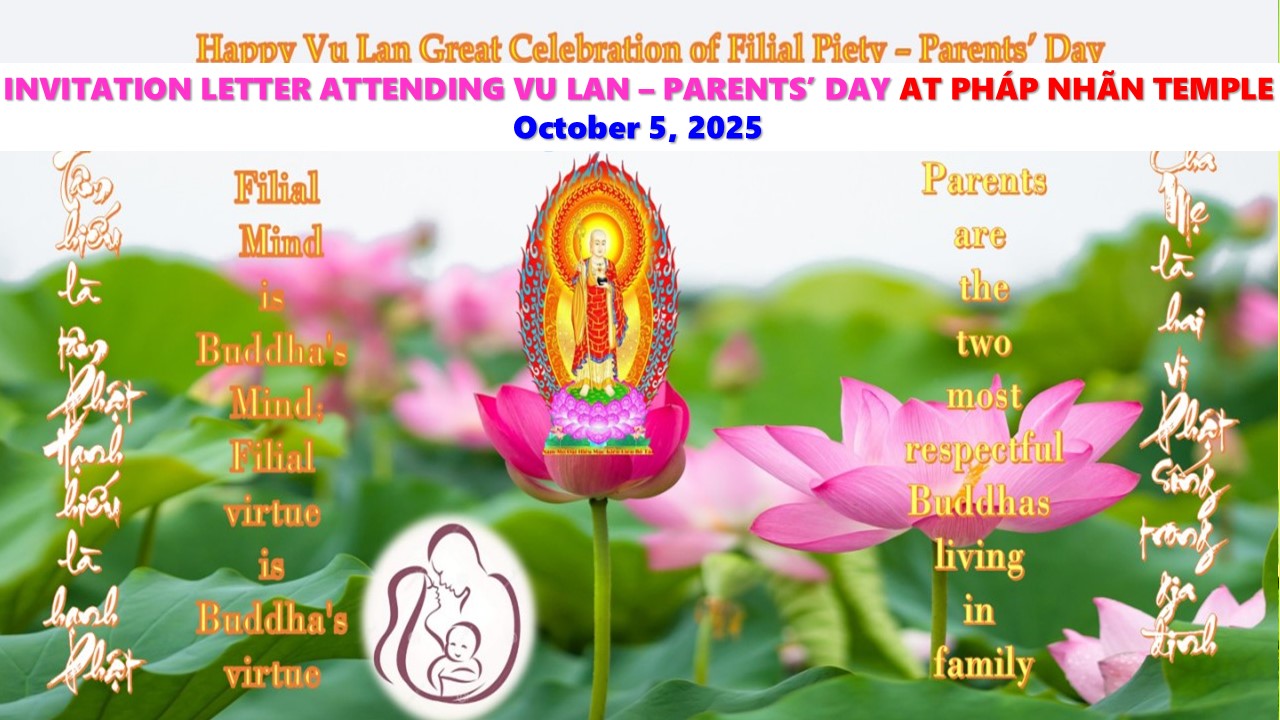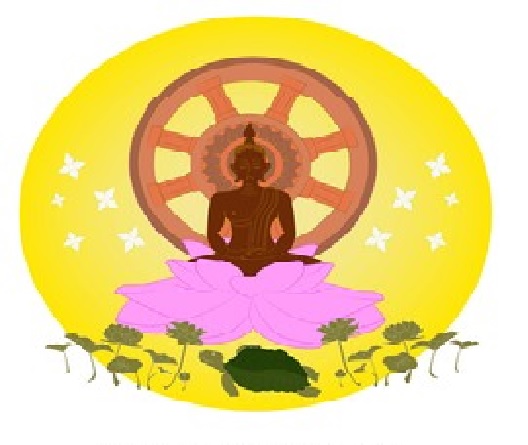
THE BUDDHA
The Buddha was neither a god nor the prophet of a god. He was born, lived and died a man. He left no room in his teachings for any other supposition. The Buddha’s mortality is man’s greatest hope for the future, since in Him we have no deity or supernatural being, but One who showed the great heights to which a man could reach. He Himself has become acknowledged as the greatest man who ever lived, but few of us will possess the courage and determination to approximate His great example. Yet it is within the province of all of us to follow His Teachings and eventually attain the Goal of Sublime Peace. We can do this without becoming Buddhas ourselves, (although it is in the nature of everyman to become a Buddha), by following the Path of Deliverance which we call the Buddha Sasana, or as it is known among western people Buddhism.
Let us learn more about this man, who conquered what is least easily conquered; who attained what is least easy to attain; and who left the world a treasure of philosophy which has been the guiding light for a great part of mankind and which has endured for more than twenty-five centuries. He was born about 623 BC, at Kapilavatthu, a hundred miles north-east of Benares, at the foot of the majestic Himalayas. The city of Kapilavatthu was once the small capital of the Sakya Clan, an Aryan people who had the same ancestors as the people of Europe, America and Australia claim today. The area now lies within the frontiers of Nepal.
The son of a noble family and having advantages denied to many, he enjoyed the pleasures of life which come easily to a child born of wealthy parents. After he passed the stage of boyhood and became a young man, his thoughts turned to the suffering of mankind which the philosophies of those days held to be inescapable. He realized that although wealth and position gave great advantages over less fortunate people, it could not save one from the sufferings of birth, disease, old-age or death. While confronted with this problem, the transient pleasures of life began to lose their value and he not only felt that there must be some way of escape from suffering, but he was determined to find it.
He was not the first to recognize the universal nature of suffering, for many in those days, had sought or were seeking for a cure, but none had ever been successful. With the determination, that he would seek and find, he renounced his home, family and position; and clad in the yellow robes of a penniless mendicant, wandered alone to find Eternal Peace.
At his birth he had been named Siddhattha Gotama, but after the renunciation, he became known as the Sage or Ascetic Gotama. Gotama was the family name of his father. He did not shrink from experimenting with the most painful and tedious practices which were so highly praised. It was the current belief that the greater the suffering endured during this life, the better would be the rebirth into the next, until suffering disappeared.
For six long weary years, he went from teacher to teacher, and though he learned much, he knew their doctrines could not lead him to the Goal he sought. The austerity and fasting were taken to the extreme limits until he nearly died for want of food. Even this desperate situation he turned to profit because it brought him to the realization that if the Goal was ever to be attained, he would need health and strength to do so. He reverted to a normal diet and a balanced mode of living, but in so doing, earned the disgust of his followers, for they considered him to have abandoned the struggle and to be seeking a life of luxury.
This, however, was far from the case. Although these disciples deserted him, he continued the search with as much intensity as before. The difference was a mode of living, which avoided extreme practices which were useless and even ruined the health. He called this the Middle way or the Middle Path. Now he was alone again but still he journeyed on and on meditating and thinking things over whenever he rested. None who saw him walking the dusty road or sitting beneath a shady tree could guess that he was soon to undergo the greatest event in history and unfold the most momentous discovery of mankind.
On, on he went, until he came to a quiet and beautiful spot near Uruvela on the banks of the Neranjara River. Nearby was a village where he could beg food and here also was a giant tree, of the species Ficus Religiosa, under which he sheltered and meditated.
The moment he had sought so long, now came, and beneath this tree, which became the Bodhi-tree or Tree of Awakening, he attained Supreme Enlightenment and became the BUDDHA or Enlightened One. By virtue of this phenomenon, the vast panorama of life and philosophy, fell together like the interlocking pieces of a jig-saw puzzle, into one complete whole. He had realized Truth and the exact nature of Reality and the Dhamma or Law of life became known by man for the deliverance of mankind.
For forty five years He preached, counseled and instructed. Thousands followed His way of life or became His lay-followers. The rich and noble, the low born and the poor, flocked to hear Him preach and to find happiness and grace in his Teachings. Although many of His supporters were kings and princes, the Buddha recognized no nobility of caste except that which a man attained by his morality and purity. In the Sangha, or Order of Monks, which He founded, He admitted alike the nobleman, the merchant or scavenger.
At the age of eighty, the Lord passed away at Kusinara and so closed a life of unequalled struggle and unselfish service to mankind. Soon after His death, His immediate followers, collected together all the sermons, teachings and rules of conduct for the monks. At first these were preserved by memory but were later written down in palm-leaf books. These Teachings have been carefully preserved and passed down through the centuries. Today, they rank as some of the world’s greatest literature and serve as an unfailing guide just like they have done in the past.
THE FOUNDATION OF RIGHT LIVING
In the first sermon which the Buddha preached, after attaining His Enlightenment, He explained the Middle Way, the Four Noble Truths and the Noble Eightfold Path. These may be likened to foundation stones on which the entire Dhamma is based. Everything which is found in the entire Buddhist Scriptures, is in fact, an expansion of the Four Noble Truths.
The Middle Way is the Path of moderation, the Path of balance. We are warned to avoid abandoning ourselves to a pleasure-seeking life and the unbridled gratification of the senses. On the other hand, we should avoid a useless life of painful and unnecessary austerity or asceticism. Since the Four Noble Truths form such an important basis of the Buddhist life, we should study them seriously and not be deceived by their apparent simplicity. In the study of Buddhism, a mere superficial glance or even the learning and repetition of words is useless unless it leads us to deep understanding. A boy can learn the four Noble Truths in ten minutes yet it may take thousands of lives before there is real understanding. The Master Himself stressed the importance of real understanding when He said:
“It was through not understanding, not penetrating four things, that I, disciples, as well as you, have wandered so long through the long round of rebirths. What are these four things? They are:
The Noble Truth of Suffering;
The Noble Truth of the Origin of Suffering;
The Noble Truth of the Cure of Suffering;
The Noble Truth of the Path which leads to the End of Suffering.“
The First Noble Truth is the Universal Nature of Suffering.
We understand this Truth when we awaken to the realization that sorrow and suffering are the principal characteristics of life. All living beings (human or animal) without exception are subject to the ever-present danger of pain and suffering. There are no conditions which guarantee happiness, peace or security. At any hour, or even any moment, we are likely to become victims.
What can be classified as Suffering? Birth, death, old-age, hunger, thirst, heat and cold, abnormal functioning of the body, disease, sickness and accidents. All these are Suffering. To be separated from the people we love or to live with unpleasing and difficult people; mental worry, anxiety, anguish, grief, woe and despair; not to obtain the objects of our desires; dwelling in unfit or uncongenial surroundings or having unpleasant employment; irritating noises and discordant sounds; mental or physical ill-health in ourselves or in those we love; suffering endured by those to whom we are attached. Suffering must be viewed in its correct perspective. It has attended us in the past, envelopes us in the present and will be with us in the future – unless we take active steps to escape it.
The Second Noble Truth Is The Origin Of Suffering.
In this we learn of the desires and emotions which are factors causing suffering, either in this life or a subsequent one. They include greed; attachment to or infatuation with people, ideas or objects; the failure to obtain or satisfy our desires; the unhappiness and disgust which comes from these people, ideas or objects, sooner or later. Restlessness, ambition, self-exaltation, pride, vanity, delusion, craving; the belief that the ego, or personality, is a permanent soul or entity.
The failure to learn from our past experiences; forgetting the tragedies of life by losing them in a round of artificial pleasures; insufficient self-control, immoderate living, anger, ill-will, hatred and irritability; bad habits, sexual excess; and putting reliance in others. In the past and in the present, all these and many more, are the cause of suffering.
The Third Noble Truth Of The Cure Of Suffering.
The threshold of understanding is reached when we realize that suffering can be brought to an end. The Path of the Master leads to this very goal. Suffering, although accepted by so many, is not without a remedy. Once the mind is awakened to the existence and causes, we are on the road to conquering them. Just how far we are prepared to go along the Path, depends entirely on ourselves. The causes can only be removed if we undertake a course of self discipline and training. The realization that it is worthwhile to do so, is the first step.
The Fourth Noble Truth Of The Path Which Leads To The End Of Suffering.
No other religion or philosophy reveals so clearly the Path of Virtue, leading to deliverance. It is called the Noble Eightfold Path because it is actually one path but is subdivided into eight sections. It is the Buddhist code of mental and physical conduct which leads to the end of suffering, sorrow and despair; to the Perfect Peace, Nibbana.
- Right Understanding
- Right Thoughts
- Right Speech
- Right Actions
- Right Livelihood
- Right Effort
- Right Mindfulness
- Right Concentration
“This is the Middle Path which the Perfect One has discovered, which makes us both see and know, which leads to peace, to discernment, to enlightenment and to Nibbana.”
The eight sections of the Path are not intended to be cultivated in the order they are given and the perfection of one stage is not required before another is begun. They must be regarded as a complete whole, requiring progress in all the sections. We practise and develop as we are able and progress in any section will lead to success in others. In its entirety, the Eightfold Path, leads to the cultured mind, for only when it is brought under control are we able to conquer greed, ill-will and delusion.
Right Understanding is the complete and perfect knowledge of Four Noble Truths and Anicca (impermanence); Anatta (all things are without a Self or permanent ego); Dukkha (Suffering); Kamma and Rebirth; the understanding of which are good deeds or bad; the Ten Fetters and the Causal Law; and their inter-relationship with each other.
Right Thoughts are those free from lust, greed and desire; those free from hatred or ill-will; those free from cruelty, unkindness or revenge. In the last analysis, it is thoughts which promote our deeds and if the thinking is promoted to a high level our deeds and actions will automatically respond. Thinking is the action of the mind and can cause bad Kamma just as much as physical deeds.
Right Speech is the control of the tongue by right thought. Withholding oneself from untruthful, deceitful or harsh speech and from gossip or idle talk. In its positive aspect, it means to speak kindly and with tenderness to others; to be modest in referring to oneself and abstain from self-exaltation.
Right Action is not to take the life of any living creature; not to indulge in improper sex relations; not to steal the property of another. In its fullest sense, it means to perform deeds which do not cause suffering of oneself and others.
Right Livelihood is to avoid occupations, hobbies or trades which cause or lead to suffering for other beings. This would include those which do no permit the practice of right action. A disciple of the Buddha should not obtain his or her living by deceit, trickery, or usury. He or she should avoid the trade in arms and death-dealing weapons, flesh, intoxicating drinks and drugs or of living beings. Our guiding principle is to work for the happiness and welfare of mankind and not for its sorrow.
Right Effort is the endeavor we make to live a moral and blameless life. The Four Right Efforts are classified as follows:
The effort to avoid evil not yet existing.
The effort to overcome evil which already exists. The effort to develop good not yet existing.
The effort to preserve the good already developed.
Right Mindfulness is to be constantly vigilant over our thoughts, speech and actions. It is easier for us to do wrong when we are careless and thoughtless. We must cultivate an alertness of mind, which in controlling our conduct, will establish harmony and not discord. The early stages of the development of this mindfulness, will require a slowing down of our thinking, speech and actions. This gives us more time to consider the right or wrong of what we are going to say or do. In a short time the mind becomes trained to this positive thinking and saying or doing the right thing becomes automatic.
Right Concentration (or meditation). Of all the gems of the Buddha’s Teaching, this is the one of greatest brilliance. Meditation is fairly new to the West but it has been known for thousands of years in the East. Already, however, there are many who have discovered its worth and the wonderful bliss of contentment it gives. It is unsurpassed as the means of obtaining the peace of mind which the wise are seeking to supplant the chaotic existence of modern living. It is not only the key to mind training but also the means by which we bring the mind under control. It opens the gate to insight and understanding of the Four Noble Truths, Anicca, Dukkha, Anatta, and leads to the unsurpassed vision of Reality and Truth.
Skillful concentration and meditation are synonyms in Buddhist Philosophy. Meditation is not, as some believe, sitting quietly and letting the mind wander with the hope that some superior, or hitherto unrevealed wisdom, will drift in. Buddhist meditation is the exact opposite. After we have learned to sit still and relaxed for a reasonable period, we endeavor to develop ‘one-pointedness of mind.’ This means, training it to concentrate on one subject only, without jumping from idea to idea, like a monkey jumping from tree to tree. Unfortunately the subject is too vast to deal with here but it is hoped to deal with it more fully in a later publication.
THE GOAL
The goal of most religions is either vague, ill-defined or without appeal to the modern mind. Heaven and Hell, Paradise and Purgatory, are the products of man’s primitive past and served to account for mysteries which could not be otherwise explained. None of these concepts occur in Buddhist Philosophy. Scientific discoveries and advancing knowledge are playing havoc with these legendary beliefs. As these, and many other ideas, crumble before the onslaught of science, we observe, the astounding fact that the Dhamma, in spite of its ancient origin, is being vindicated.
We are finding, more and more, that the discoveries over the last decade were taught by the Buddha more than twenty- five centuries ago. This, however, will not surprise those who understand the profound depth of the phenomena of Enlightenment, or that the Buddha when He attained it, had insight into the facts of life which would naturally conform to the knowledge which science has unraveled.
The Buddha explained, in simple language, that if we fulfill the obligations of morality, we can overcome the continual horror of rebirth. This morality is the Noble Eightfold path which leads to the end of greed, hatred and delusion. This is the goal and we call it Nibbana. It is not a place where people go when they die or a land of departed spirits. It is a state of utter tranquility of the mind which we can enjoy in this life, leaving no conditions which will give rise to a new birth.
For most of us it has taken countless rebirths to arrive at our present standard. How many more will be required to reach the perfection of Nibbana, depends on the efforts we are prepared to make now.
The Master never pretended that the Path was easy one. The attainment of the goal requires both understanding and determination, but to say it is not easy does not mean that it is impossible to follow for an intelligent man or woman.
Buddhism, or the Buddhist way of life, may be described as good conduct brought about by mind development and training and leading to Perfect Peace. The Buddha made an unsurpassed analysis of the evils and troubles of mankind. They were due, He said, to Greed, Ill-Will and Delusion.
It would be difficult to find any man-made evil or tragedy which did not fall under one or more of these categories. Yet it is precisely the conquest, the overcoming, of greed, hatred and delusion which lifts us to attain Nibbana which is, “Tranquility of the mind when the passions are brought under control and all attachment ceases.”
The fruits of the Buddhist way of life are both immediate and ultimate. Results are very quickly observed by those who accept the Dhamma and begin to walk on the Path of the Master. If we do not attain Nibbana in this life, the experiences and progress we have made, not only lead to a more rapid attainment in a successive birth, but will provide more favourable conditions to do so.
The more immediate fruits of happier living, contentment and peace of mind, are the priceless rewards of those who walk in the Light of the Buddha’s Teaching.
“Through greed, ill-will and delusion, and through being overwhelmed by them, one aims at the ruin of oneself, of others, and of both parties, and mental pain and grief come about. But when greed, ill-will and delusion are overcome, one aims at neither the ruin of oneself, of others, or of either party, and mental pain and grief are not brought about.” (Ang Nikaya 3).
“There, Ananda, the disciple considers thus: This is Peace, this is the Sublime, this is the end of all rebirth producing Kamma, the relinguishing of all the underlying causes of existence, the fading away of craving, the attainment of detachment, Nibbana.” (ibid)
“The extinction of greed, the extinction of anger, and the extinction of delusion: this indeed is called Nibbana.” (Sang. Nik 38)
KAMMA AND REBIRTH
Kamma is a Pali word which means ‘action.’ We have no suitable word in the English language which exactly expresses the meaning. It is for this reason that we use the Pali term here. It is sometimes known by the Sanskrit term, Karma, but the Hindu conception is very different from Kamma as taught by the Buddha and it would be better not to use it in this document.
Kamma can be described as the impersonal force which determines our circumstances in this life and fashions our conditions in the future. It is the energy which survives man at death and links this life with the next. If there is no Kamma there is no rebirth. Nothing of the mind or body is reborn but only this powerful energy Kamma.
We have already explained that the Buddha’s Path was one of good conduct or high morality. By observing this code we do not perform bad actions or deeds and therefore, do not create bad Kamma. If we live an unrestrained life, responding to desires, cravings, and passions of the senses, we produce bad Kamma. Kamma is therefore, good or bad according to our deeds, of mind, speech, or body. Both good and bad Kamma can produce rebirth, but the good will naturally bring about conditions which are favourable, while the bad will produce circumstances which no wise individual would seek.
The state of Nibbana does not result from either good or bad Kamma, but only from the extinction of all Kamma. A person who reaches the state of Nibbana and who will not be reborn is called an Arahant.
The results of good or bad Kamma can be experienced in this life, the next or a subsequent one.
The inconsistencies of life and the unequal conditions into which people are born, give the intelligent cause for very serious thinking. Why are some born rich while others poor? Why does one prosper and another fail? Some are clever and some are dull; others are gifted with great charm and beauty while others lack these qualities. Why is one born maimed or to a life of sickness, while others, less worthy, enjoy good health? Why should one baby be taken to the grave while another lives to old age? The good man is often beset with misfortune while the scoundrel prospers.
Western philosophies have no satisfactory answers to these questions which can only be explained by Kamma. We have stressed the scientific nature of the Dhamma, but in the case of Kamma and rebirth, we are in a similar position to the scientist when he is asked to prove the atomic theory, gravity, evolution or electricity. We are told that ‘proof,’ as we often understand the word, cannot be given. Much scientific knowledge is accepted because there is no other possible explanation of a phenomenon. Most scientists are now learning to apply and use matter and radiation without waiting for it to be put into a test tube. Knowledge of Kamma and rebirth is the logical outcome of the observation of natural phenomena.
There have been many attempts in the past to explain a person’s character only by hereditary and environment, but this left so many vital problems unanswered. Only in the light of Kamma does the enigma become solved, and we can see that living beings are the result of their own good or bad actions. This enlightened knowledge is of paramount importance to mankind, since if the past can condition the present, we know that our conduct today will determine our future.
Science is making rapid strides, yet showing that not everything can be weighed in a balance or placed in a test tube. Many of the greatest mysteries, while much in evidence, still have no explanation. This is especially true in the field of psychology and psychiatry.
Turning to the issue of rebirth, beings tend to be reborn at a lower rather than a higher level. The vast majority of mankind responds too readily to the baser instincts and desires, evil passions and attachments to things and ideas, thereby conditioning their future on a lower level. Most of the natural instincts and desires produce bad Kamma and it is only when we develop the intelligence to place ourselves under the right Teacher, that we can be sure of progress. But merely wearing the label of ‘Buddhist’ is useless if we do not learn to control the mind and observe the morality.
Not everything that happens to us is the result of past Kamma. We are subject, by the fact that we exist, to suffering from natural causes, as well as the deeds of our actions. However, while Kamma may condition the circumstances, it cannot make us commit a crime if we do not so desire.
In life, we are not pawns in a game, but the makers of the game. We cannot, of course, undo our past, but with this vital knowledge at our disposal, we can shape for ourselves a joyful future.
From the mistakes and blunders of the past we have built our present, but man is equally the architect of his own future and with the right guidance we can be sure of it being a happy one.
THE CAUSAL LAW
Man cannot escape his past. According to the Buddha it conditions the circumstances of the present. Among these circumstances are included our characters, which even among brothers, so often differ. If the past is beyond repair, we can at least gain by the experience and act with greater caution for the future.
The law of cause and effect is so indisputably accepted today, even taught in schools, that we do not need to prove it here. We generally accept that nothing arises without a cause and that we can take the chain of causes beyond human conception. This can be applied to past, present and future. Today nobody would refute this simple principle which is comparatively new to western thought although the Buddhists have known it for thousands of years.
The Buddha took the law to its logical conclusion and applied it to our lives. Through our ignorance in the past we have become possessed of rebirth-producing Kamma. With this Kamma and the new birth there arises mind and body (including consciousness). These give rise to the senses and the sensations we experience. Our sensations manifest themselves as desires and attachments to things and ideas.
These determine our actions and therefore Kamma, which in turn brings about rebirth. Rebirth provides the condition for more mind and body, more sense and craving, more Kamma, and further rebirth. So the chain goes on and on. It may go on and on, unless we find the key to break the chain and bring it to an end.
Where is the chain to be broken? The links which seem the strongest are also the only ones we can sever ourselves. They are the links of craving and attachment. Conquer these and you conquer rebirth, suffering, woe and despair.
THE SIGNS OF LIFE
The Signs of Life, sometimes known as the Three Characteristics, are the immutable laws which conditions all beings. These three Signs, or laws, are, Anicca, Dukkha, Anatta. These mean Impermanence, Suffering, Without Self or Soul. All living beings, without exception, are subject to these three characteristics. They constitute the natural laws of the physical world and are scientific in all their aspects.
Anicca, or impermanence, goes beyond the scope of living beings and applies to everything in the universe. Nothing which takes form can endure for eternity. Sooner or later it will be worn away, broken, destroyed or disintegrated, providing the material from which new forms come into being. This law operates without limit, from the tiniest grain of dust to the largest star in the universe.
Everything is in a constant state of flux, coming into being and passing away. Nothing is still for a moment and therefore nothing can be enduring or permanent. Only in the mind’s eye do we conceive things as still or stationary. All phenomena and all natural laws are the result of this flux or movement.
Dukkha, or suffering, has already been discussed under the Four Noble Truths. It will, however, be of value to consider why suffering is not always so obvious to all human beings. People, whom we know have been through ‘livinghell’ in the manifold aspects of life, often astound us when we hear them say that life is not so bad after all.
To understand this strange attitude, and also the incongruity that those who suffer most are seldom the ones who are seeking an escape from suffering, we must consider the delusive instrument that the mind can be.
There is a very interesting mechanism in the mind which makes us forget unpleasant things and experiences. Let us take any single individual at the moment of great suffering or sorrow and compare them in a later period.
Young Mr. A has just had a quarrel with his girl friend. He makes himself unbearable to everybody by his misery. When his friends tell him he will soon recover from his sorrow, he responds with a desire for death. He alone knows, in that moment of anguish, that he will never, never, recover from his grief.
A few weeks later we meet Mr. A but he no longer presents the sad and abject figure of a few weeks ago. He is now smiling and is anything but a picture of unhappiness. He has a new girl on his arm.
Let us turn to Mrs. B. Her face is red, her eyes are swollen and every few moments she gives vent to a pitiful howl. The mother of Mrs. B, subject to the law of impermanence, has just died. Her loving daughter has often been unhappy, but never quite like this. “You can bury me too,” she tells her audience, “I don’t want to live without mother.” Fortunately they do not concede to her request and she lives to recover.
Six months later she is cracking jokes about the funeral and even about the ‘old lady.’
Ah! Here is another unfortunate case, hurrying along the road. This is Mr. C, who, caught up in the wheel of life finds himself late for work. Since his employer keeps a well-oiled clock to check his coming and going, it becomes necessary to move beyond the normal hurried pace and try to make up the lost time. In a desperate hurry to cross the road, he meets another gentleman who also is caught up in the wheel of life but has the advantage of driving a small car. Though the meeting is very brief, it ends badly for Mr. C, whose total gains are, one broken arm, one broken leg and several crushed ribs, without mentioning numerous cuts and bruises to add color to an otherwise dismal scene.
The driver of the car, realizing that his vehicle of rapid transport is also a lethal weapon, vows he will never drive again. He is convinced that Mr. C is dead and that he himself is a murderer of a married man with a large family.
Months later Mr. C has been discharged from hospital and has recovered, in part, his financial losses through insurance claims. He is laughing and joking about the fools that thought that he would not live, but has quite forgotten that, at the time, he also thought so too. The weeping and wailing has died away and laughter reigns supreme. The driver of the car, also presents a different aspect to the one on the day of the accident. Here he is now, laughing and drinking with his friends (also car drivers) and relating to them the story of ‘the pedestrian who got away.’
One moment tragedy, next moment laughter. What has happened to these people? Why is it that the disaster of today can become the jest of tomorrow? The answer is, of course, this mysterious mechanism of the mind which makes us forget. If it were not for its ability to do this, we would either lose our life or reason because the human mind could not stand such suffering, week after week and month after month. Yet this faculty of the mind which preserves our health and sanity, also deludes us into thinking that life is much happier than it actually is. At the height of a tragedy, people are quite willing to acknowledge the futility and uselessness of life, but when the sorrow is passed and almost forgotten, then living and all its delusions present a very different picture.
Meditation awakens the mind to the realities of life and clears away these delusions.
Suffering, in this life, comes from three main causes:
- a) man in conflict with nature;
b) man in conflict with other human beings; and
c) man in conflict with himself.
A huge percentage of the suffering we experience is brought about through man’s inhumanity to man. It can manifest itself as the antics of the practical joker, who under the cloak of good clean honest fun, makes the lives of his friends and family miserable. Or we find it in the surly individual who wishes to share his unhappiness with others. At the extreme end of the chain are men in conflict with men they have never known or met, raining death and destruction on a world-wide scale. Such is the nature of things.
Yet this war among humans has gone on for thousands of years and even has its counterpart in the animal kingdom. The solution is not in reforming the world at large, but in reforming ourselves. The Dhamma will place us in a better relationship with things as they exist and will guide us along the road until suffering ceases. The Buddha has shown us that although we should help others to find the path, we cannot earn or give salvation to others. In this sense, Buddhism is a very personal religion or philosophy because each must walk this path for himself and win his own Nibbana.
Anatta, or soullessness, applies to everything that exists but we are concerned with it mainly in relation to living beings. All things that live are without a soul or self, without a permanent and enduring ego or personality. Soul or self is philosophical conception of an immaterial part of man which survives and endures death and destruction of the body.
Science today does not support this legendary belief but recognizes the existence of the human ego or personality, as an aspect of the mind. It is astounding how close Buddhism is running with the scientific thinking of today. This ego or personality is often confused by unenlightened people, with a soul or spirit. This individual character has nothing to do with soul-theory for while we can recognize the versatile and changing character of the personality, a permanent soul or spirit cannot exist in nature.
Western people generally begin an investigation into the Buddha’s Doctrine of Anatta, at a great disadvantage. From childhood they have been raised and taught to accept this soul-teaching and some do not find it easy to reject. Those who experience any difficulty with this or any other aspect of the Dhamma, should not worry because everything will unfold itself as they progress.
Whereas the soul is supposed to be capable of separate existence, we know that the Dhamma clearly reveals that the ego or personality can have no existence apart from the functioning of the mind and body. It is fact only a function of the mind and not an entity. This ego may play a great part in making Kamma (good or bad), but it cannot pass beyond death and therefore into a new birth.
Its greatest importance is that it gives rise to the delusion of ‘I,’ ‘me’ and ‘mine.’ In our relationships with other beings, this is one of the factors which matters most.
Modern psychology has made some wonderful discoveries over the past few years and yet they are old by Buddhist standards.
Let us quote from Dr. Graham Howe, one of Britain’s top- raking Psychiatrists and a Harley Street Specialist:
“To read a little of Buddhism is to realize that the Buddhist knew, two thousand five hundred years ago, far
more about our modern problems of psychology than they have been given credit for. They studied these problems long ago and found the answers also. We are now rediscovering the Ancient Wisdom of the East.”
The Buddha was the first to throw intelligent light on the mind process. The important thing for us to remember is that the mind controls the speech and body action, so that the nature of the mind determines what we say and do.
This mind process, being a constant feature of our lives, is often interpreted as a soul or spirit. It is now known that the soul illusion grew out of primitive man’s dream experiences. Seeing departed friends and relatives, in the mind’s eye during sleep, must have suggested to him that they were living a spirit existence in a spirit land.
However primitive this belief is and though science has discarded it, we still find many people hanging on to their souls and selves with even more tenacity than their primitive ancestors.
The Dhamma and modern science, both teach the same fundamental; that man is composed of Mind and Body; nothing else. These two are interrelated and one does not survive the other at death. Both are one complete unit which we call a human being and sooner or later will yield to the law of impermanence.
CONFIDENCE IN ONESELF
Because the Buddha taught his followers that they themselves make or mar their own happiness, it becomes necessary for us to rely on our own efforts and not seek salvation from a deity or supernatural being. Now if man must rely on himself, it is weakness to seek aid and favors by praying. Instead of prayer, He taught us to meditate and develop the mind so that we would be able to face the difficulties of life, and overcome them.
Neither suffering nor happiness is permanent. It only requires a little patience and fortitude to wait for things to change. The Buddhist is at a great advantage with this knowledge, because he does not lose sight of reality during the happy moments and he does not give way to despair in the face of misfortune. The Buddhist knows that existence is controlled by balanced natural laws and prayer can only be to express a desire that these shall change for one’s individual benefit, or that we wish for something we have not earned or are entitled to. If natural laws could be upset in this way we would be obtaining things at the expense of someone else.
The Buddha was not silent on the matter of deities possessing creative power or controlling the destiny of men. He not only explained the real nature of things but derided the idea of the all-powerful Creator. He went further and showed us that such superstitious beliefs were harmful if people relied on gods to do what only they could do for themselves.
We are not asked to accept that the universe was created from nothing or that a deity had achieved the impossible. Matter, we know today, cannot be destroyed and cannot be produced from nothing. For centuries, men have speculated about the beginning and end of life and the universe, although they are matters beyond the conception of the human mind. The Master advises us not to participate in this useless speculation because they are problems to which we cannot find the answer, and which have nothing to do with the moral life or helping us to the goal of Nibbana.
FAITH OR CONFIDENCE
In practically every one of the great religions of the world, ‘faith’ is required of the followers, because many of the teachings and doctrines are incompatible with reason. The Dhamma strikes a great contrast in this respect. The Buddha asked only for the confidence, based on understanding and reason. Blind acceptance is of no use to an individual because it does not require the depth of knowledge which makes it of value or serve as a guide on the Path. This broad outlook is probably one of the reasons why it is now finding so many ready converts in the West.
There are no dogmas or articles or creed or faith in Buddhism. No disciple is asked to accept anything until he is ready to do so and there are no confirmations of beliefs or creeds to recite.
The Master, on many occasions, stressed the need for one to consider and carefully investigate, before acceptance. That is why, in Buddhism, there are no records where it has sought converts at the point of a gun or under the threat of torture. People can only become good followers of the Enlightened One when they are convinced of the superiority of the Buddha Sasana, as a way of life, over all other systems. He never encouraged hysterical or emotional acceptance of the Dhamma. If people appeared too ready to do so, He advised that they took more time to carefully consider the matter.
There is a notable example of this in Buddhist history. It is recorded, that during the time of the Buddha’s ministry, there was a certain General of the Licchavis, named Siha, who was a follower of the Jains. This was a sect which existed about the same time as Buddhism. Siha discussed his intention of visiting the recluse Gotama, with Nataputta, their leader. Nataputta did not favour this suggestion and tried to discourage Siha from making the visit. He did not wish to lose a wealthy and influential supporter like Siha and wished to take no chances of doing so. However, in spite of Nataputta’s advice, the General decided he would go and see Gotama for himself and find what He was teaching.
The next day he saw the Enlightened One and questioned Him. The first discovery he was to make was that the Jains had given him a distorted account of be Buddha’s Dhamma, and as soon as he heard the real doctrine he knew that he had found the philosophy he had been seeking. As the Master unfolded the fundamentals of the Higher Life, His listener knew that here was a Teacher among Teachers.
Siha responded to this realization by asking the Buddha to accept him as a layfollower, to take refuge in Him and the Dhamma, for the remainder of his life. The Exalted One’s reply came as great surprise to Siha when He tried to discourage him from accepting after so short a discussion. The Lord pointed out the position and responsibility of Siha in the community, and in the case of well-known and important citizens, it was advisable to make a thorough investigation before embracing a new teaching.
This, however, only increased Siha’s enthusiasm for the Buddha. He knew that if the position had been reversed, and he had left the Buddha to follow the Jains, they would not only have accepted him without hesitation, but proclaimed his new discipleship far and wide. Three times the Lord repeated this advice but Siha had firmly made up his mind.
This, however, was not the conclusion. The Enlightened One pointed out, that Siha and his family had for a long time been supporters of the Jains, and even though he may not wish to follow their philosophy, he should continue to give alms to any of them that asked.
Here again Siha knew that this was not the instruction he would have received from the sect he had just left and his confidence in the Master rose higher and higher.
Then the Lord instructed Siha further, discussing morality and the goal; the perils from the pleasures of the sense and the advantages of conquering them. Then He taught him the nature of suffering, its cause, its cure and the Path. In this manner did Siha, the General, became numbered among the followers of the Enlightened One.
At this stage, we must quote the instructions given by the Buddha to the Kalamas of Kesaputta, when they pointed out that all teachers extol and magnify their own views, claming that their doctrine is the only right one. This only left them confused and they did not know how to judge the true from the false.
After explaining that they did right to doubt if they did not properly understand, He said:
“Do not go by what is reported by others, what is hearsay or taught by tradition. Do not go by proficiency in reciting the scriptures or by mere logic and inference; nor because it fits in with views already held; nor out of respect for your teacher. It is only when you know for yourselves that these teachings are good, they are acceptable by the wise, that when practised they do not conduce to loss or suffering; then only must you accept them.”
HOMAGE TO THE BUDDHA
The homage and respect paid to the Buddha, is but a symbolic veneration of His greatness and the happiness we find in His Teaching. The Master is, at all times, an example in thought and deed, of the way and manner we should conduct ourselves. It is therefore, not unnatural that this respect should express itself in some of the finest and most beautiful art and sculpture the world has ever seen.
The images we see of the Buddha, are symbolic representations of qualities and do not pretend to be ‘photographic’ likenesses. It was hundreds of years after the Master’s death that these images began to appear. In the very oldest sculptures and paintings, the Buddha was represented by a wheel or footprint, while in some cases; a blank space was used to indicate, rather than portray, His presence. The first images were made by Greek converts to Buddhism, at Gandhara in North-West India. These Greek craftsmen gave the images the same likeness as Apollo. These sculptures, and the millions which have followed, have given a tangible representation of the Buddha to many.
There are no esoteric or exotic Teachings of the Master. He did not expound one thing to the public and keep back some secret information for a few chosen disciples. That which He knew was necessary for man’s salvation, He taught freely to all.
It must, however, be realized, that though there is none of this esoteric and exoteric discrimination, there remains a considerable difference of understanding among the millions of His followers. discrimination, there remains a considerable difference of understanding among the millions of His followers. Complete understanding of the Dhamma, requires a greater depth of vision than many possess.
In Asia today, there are among the many millions, those to whom the Buddha is simply an object of veneration. Yet because the Dhamma is an all-embracing way of life, the simple peasant with his simple views, is just as much a disciple as the monk or scholar. Simple people of all races require simple doctrines and many only conceive a mental idea through a symbolic image or ceremony. Without these tangible forms of devotion, they would have little to grasp.
Consistent with the Master’s Teaching, we know that those who are not ready for right understanding in this life, will do so in a successive birth. The important thing is to guide these people along a path of good morality so that their development is advanced in another birth. Within the Buddha Sasana we must respect the degree of another’s understanding and the point of view of those differing from ourselves. The enlightened Buddhist should be a guide but not a critic.
The Buddha, Himself, had little time for ceremonies and rituals because His way of life is a practical one of deeds and actions. In its higher stages, rules and rituals become fetters which impede the progress. The Master tells us that, the man who honors Him most is the one who practices His Teachings best.
It should also be stressed, that to follow the Buddha does not require one to abandon their home and family and to live the life of a recluse. There are many fine Buddhists today who are married men and women with families and go about their daily life in a normal way. They become outstanding among their fellow men, by virtue of their morality and good conduct and the work they are doing to make the Dhamma available to others.
Not all are ready or willing to become Buddhist monks and it is better to be a good layman than a failure in the Sangha.
THE PERFECT BLUEPRINT OF HAPPINESS
It is a frequent request of Buddhist friends for a summary of Buddhism in a few words. Perhaps the best and shortest definition I can give is that Buddhism is the adaptation of one’s life to harmonize with natural laws. Can the Dhamma do this? It both can and does.
The Pali word Dhamma is one of those all-embracing expressions which mean several things, though all of them are related. In its most common use it means Doctrine, Teaching Law, but it also can mean, Justice, Righteousness or simply Nature or Natural Law. These definitions will help us to understand the wide conception of the word and what it stands for.
If each and everyone practises this Dhamma, to the best of his ability, it means he is putting himself in harmony with Nature and the natural laws which govern the universe. This Dhamma provides us with a pattern for living which we can truly call, A Blueprint Of Happiness.
The importance of happiness cannot be over-stressed. It can only come about when we live in harmony with the natural laws which bring us health, success, contentment, tranquility and peace of mind. When we live in discord with these laws we experience sickness, failure, discontent, worry and unbalance. In its practical application to our daily life, harmony is the fruit of understanding the Dhamma, while discord is the fruit of our ignorance of it.
First let us examine the negative aspect of discord and the manner in which it arises. Discord arises through Greed, Ill- Will and Delusion:
- Greed is the cause of selfishness and avarice. Selfishness is the cause of envy and jealousy, while avarice is the cause of covetousness and the competitive spirit.
- Ill-will is the cause of resentment and anger. Resentment is the cause of pride and revenge, while anger is the cause of malice and strife.
- Delusion is the cause of attachment and fear.
Attachment is the cause of craving and lust, while fear is the cause of superstition and intolerance.
On the other hand, we can examine the positive aspect of harmony and the manner in which it arises.
Harmony arises through Charity, Love và Wisdom. Charity is the cause of nselfishness and generosity.
Unselfishness is the cause of sympathy and altruism, while generosity is the cause of equanimity and love.
Equanimity is the cause of humanity and goodwill.
Goodwill is the cause of compassion and self control. Wisdom is the cause of renunciation and serenity.
Renunciation is the cause of contentment and mental tranquility, while serenity is the cause of sound judgment and tolerance.
The right to be happy is accepted by nearly every nation, but unfortunately, the interpretation of how this happiness is acquired, is producing conflicting results. There is a popular delusion that, when an individual has piled up all the possessions he can, he will also have arrived at the state of perfect happiness. In practice we find that a state of sufficiency is never reached and the more people get, the more they want. Like the sorcerer’s apprentice, they conjure up a demon which they cannot control.
Science and invention have become debased in the mad scramble to produce more and more of these possessions, till the paraphernalia which begins to clutter up our lives, becomes the weapon of our defeat. Science in many ways has the power to make life easier, but it cannot make us happier.
The wisests in the West are seeking a new path and are turning to the East to find it. The ancient wisdom of the Enlightened One, will yet prove itself to be the only lasting solution to the ills of mankind. The path which the wise will follow is one which expresses clearly its theory and gives good results when put into practice.
DHAMMA IN THE WEST
The rise and spread of many religions has been accompanied with the ruthless slaughter and persecution of those who did not readily accept an alien creed. Buddhism writes no such pages in the world’s history. Not one drop of blood has been shed, nor a single grain of pressure used, to carry the Dhamma into other lands. For peaceful missionary work without motives, political or economic, it has a long and glorious record.
In the past just as today, our peaceful missionaries were welcomed among nations and found ready converts wherever they went. Today it is numerically the largest world religion and is still growing. The Light of the Dhamma now shines in lands, where less than a generation ago, it was unknown.
One of the first scholars to begin the work of translating the Pali Literature into English, was the son of a well-known clergyman. His object in undertaking the work was to prove the superiority of Christianity over Buddhism. He failed in this task but he achieved a greater victory than he expected. He became a Buddhist. We must never forget the happy chance which prompted him to undertake this work and thereby make the precious Dhamma available to thousands in the West.
The name of this great scholar was Dr. Rhys Davids and of the Dhamma, he himself says:
“I have examined every one of the great religions of the world and in none of them have I found anything to surpass the beauty and comprehensiveness of the Four Noble Truths of the Buddha. I am content to shape my life according to that path.”
H.G. Wells, scientist and historian, gives high praise to Buddhism as an ethical system and places the Buddha as First among the greatest men who ever lived. In his Outline of History he says:
“Over great areas of the world it still survives. It is possible that in contact with western science, and inspired by the spirit of history, the original teaching of Gotama, revived and purified, may yet play a large part in the direction of human destiny.”
The great British scientist, Thomas Huxley, though not himself a Buddhist, but influenced greatly by the Teachings, summed up the Buddha Sasana in a clear concise paragraph:
“Buddhism is a system which knows no God in the western sense, which denies a soul to man and counts the belief in immortality a blunder, which refuses any efficacy to prayer and sacrifice, which bids men to look to nothing but their own efforts for salvation, which in its originally purity knew nothing of the vows of obedience and never sought the aid of secular arm, yet spread over a considerable portion of the world with marvellous rapidity, and is still the dominant creed of a large fraction of mankind.”
Swami Vivekananda, himself a great missionary who helped to introduce oriental philosophies to the West, said this of the Buddha:
“Show me in history one character who has soared so high above all. The whole human race has produced but one such person, such high philosophy, such wide sympathy. The Great Philosopher, preaching the highest philosophy, yet has deepest of sympathy for the lowest of animals, and never put forward a claim for himself. He is the ideal Karma Yogi, acting entirely without motive and the history of humanity shows him to have been the greatest man ever born beyond compare, the greatest combination of heart and brain that ever existed.”(Lectures on Karma Yoga).
Lastly there is Professor Karl Gustav Jung of Zurich, who ranks today as the world’s leading Psychologist: “As a student of comparative religions, I believe that Buddhism is the most perfect one the world has ever seen. The philosophy of the Buddha, the theory of evolution and the law of Kamma were far superior to any other creed.”
The first converts in western lands were mainly among scholars and intellectuals. This was because the Dhamma was not easily available to the man in the street, and at first could only be studied by those having the ability to read oriental languages. Within recent years the position has entirely changed. Not only can we read the actual teachings of the Buddha in our mother tongue, but a wealth of literature has been published to make the study of the Dhamma much simpler for western inquirers.
Space will not permit us to quote further but many more could be added to these. Yet, although it is well to read the opinions of others, the real test must be made by ourselves. It will not take the average man or woman long to find and learn to love this Light of the World. Among the founders of great religions, He transcends them all in amity and compassion, not only to people of all races, colors and castes, but even to the tiniest of living creatures. No one was more worthy to be called the Compassionate One.
In wisdom also, He had no equal and stands as a giant among pigmies. He taught facts of nature, twenty five centuries ago, which western scientists have only ‘discovered’ in the last decade.
He was the first to raise the dignity of women and in the great religion. He founded, gave them equal place with men. He did not recognize caste divisions based on birth. To the Master, one became a noble by the morality of the life one led and not by the wealth or social position of the parents. This Dhamma is the greatest living force in the world today which can bring peace among men and nations.
How do we join and share membership in this great and all embracing family? There are no baptismal or initiation rites into Buddhism. We become Buddhist from that moment we accept the Buddha as our Teacher and Guide.
The past for all of us has been long and weary, but here is a Teaching we can follow with confidence. Where in the world of religions, cults and creeds, can we find a master of such brilliance? In a pageant of stars He was a giant of the greatest magnitude. Little wonder that scientists, philosophers, and men of literature have proclaimed Him the “Greatest Man Ever Born”’
The radiance of this Great Teacher goes though a world of suffering and darkness, like a beacon light to guide and illuminate mankind.
THE BLUEPRINT OF HAPPINESS
Ven. ANOMA MAHINDA



